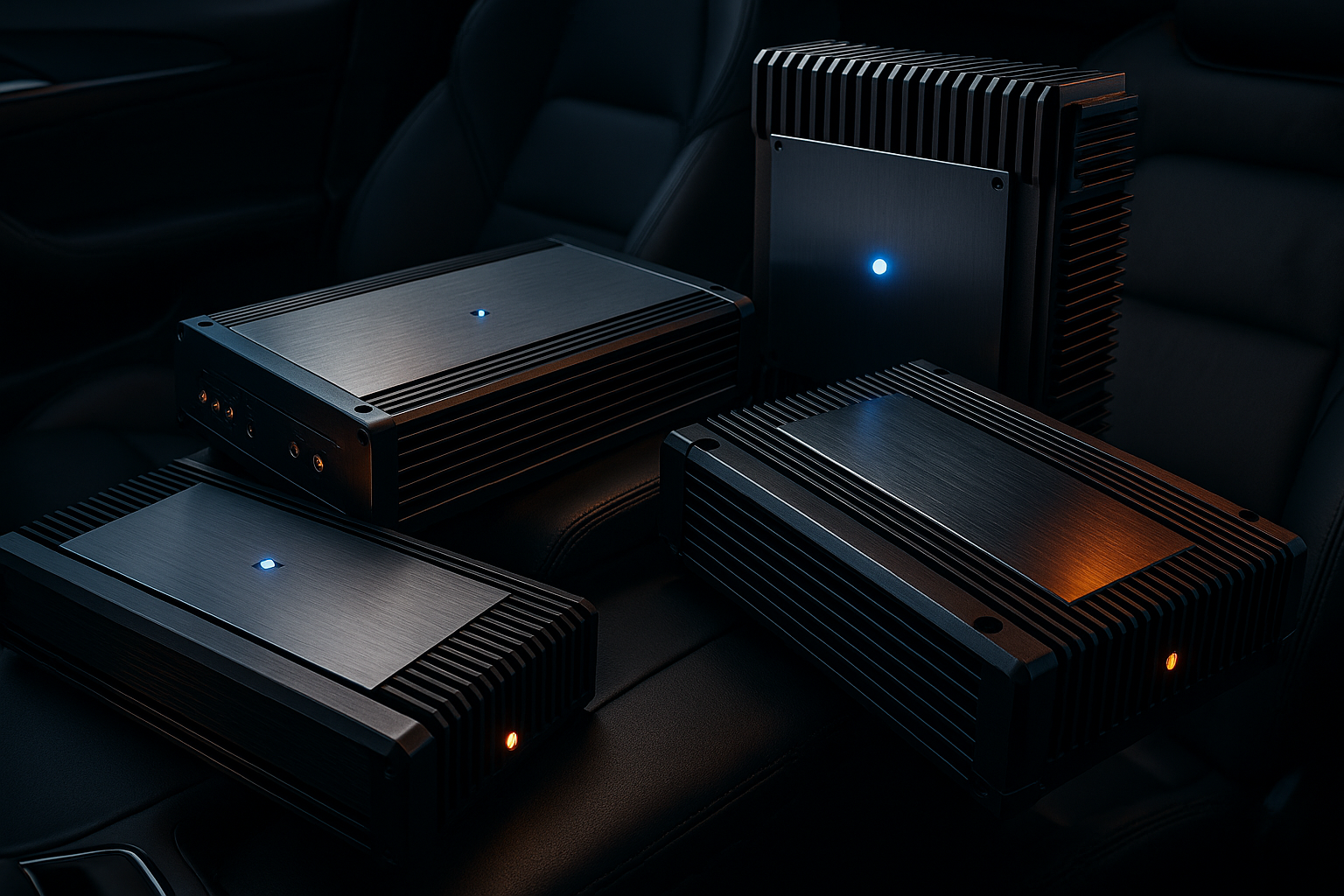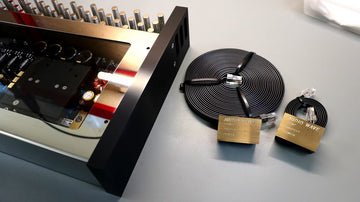
Free Shipping

Award Winning Products

778+ 5-Star Reviews

30-Day Money Back Guarantee
Car Amplifiers - Premium Audio Amplifiers for Superior Sound
Car amplifiers are the heart of every high-performance audio system, providing the clean, powerful amplification needed to drive speakers and subwoofers to their full potential. Quality car amplifiers transform your factory audio system into a dynamic, concert-quality listening experience that delivers exceptional clarity, depth, and impact.
From compact monoblock amplifiers designed for subwoofer power to versatile 4 channel amplifiers that drive complete speaker systems, the right car amplifier makes all the difference in sound quality. Modern car amplifiers feature advanced Class D technology for maximum efficiency and minimal heat generation, while premium Class AB amplifiers deliver audiophile-grade sound reproduction. Whether you're powering car speakers or driving powerful subwoofer systems, car amplifiers provide the foundation for exceptional mobile audio performance.
Channel Configuration
Discover premium car amplifiers engineered for superior sound quality and maximum power output. Our curated selection features monoblock amplifiers, multi-channel systems, and Class D technology from leading audio brands. Whether you're powering subwoofers or full-range speakers, find the perfect amplifier to transform your car audio experience.
Kicker KEY500.1 Smart Mono Amplifier | 500W RMS Class-D Car Audio Amplifier
Wavtech Link5001Mini
US Acoustics Mike 1500w Monoblock Amplifier
Image Dynamics SQ600.1D 600W Mono Block Amplifier
Wavtech link1000.1mini 1000w monoblock amplifier
Triton Audio NS12001 1200w Monoblock Class D Amplifier
Image Dynamics SQ1200.1D 1200W Mono Block Amplifier
Crescendo REVOLUTION 3A1 1 channel Amplifier
US Acoustics Big Ben 3500w Monoblock Amplifier
US Acoustics Nick 2500w Monoblock Amplifier
Wavtech Link1500.1plus Amplifier - Compact 1500W Monoblock
Crescendo REVOLUTION 5A1 1 Channel Amplifier
US Acoustics Tony 6000w Monoblock Amplifier
Kicker Warhorse WXA3600.1 Monoblock Subwoofer Amplifier
US Acoustics Phil 8000w Monoblock Amplifier
Audio Wave Excel Monoblock | Full Range Class AB 1 channel Amplifier
Audio Wave CR-30X - Class A Monoblock Amplifier
US Acoustics Wendy | 2 Channel Class AB Amplifier | 2 x 75w
Ground Zero GZIA 2.85 2-Channel High Quality Class A/B Amplifier
Ground Zero GZIA 2.135 2-Channel High Quality Class A/B Amplifier
US Acoustics Andrea | 2 Channel Class AB Amplifier | 2 x 150w
Audio Dynamics ADMK300.2 2 Channel Amplifier
Cadence XAM400.2 2-Channel Class D Powersports Amplifier - 400W RMS Orange Anodized Full Range Micro Amp
Eton Micro 120.2 2-Channel Amplifier, Class D
Ground Zero GZHA MINI TWO 2-channel class D compact amplifier
Ground Zero GZRA 2HD 2-Channel High-Performance Class D amplifier
Eton Mini 300.2 2-Channel Amplifier, Class D
Rainbow Audio SL-M2 2 channel micro amplifier
Audio Wave Excel | 2 Channel Class AB Amplifier
Audio Wave Excel CA Class A Amplifier | Previous Demo
Audio Wave Excel CA | 2 Channel Class A Amplifier
Audio Wave Aspire Pro USA
TRU Technology Billet B22-A v2.5 - 2-Channel Class A Amplifier
Audio Wave Aspire Pro USA (Display Model)
Audio Wave Aspire Pro V2 Class A 2-Channel Amplifier
Audio Wave Aspire Pro V2 Class A 2-Channel Amplifier | Previous Display
Rainbow Audio SL-M4 4 channel micro amplifier
US Acoustics Lisa | 4 Channel Class AB Amplifier | 4 x 50w
Feelart AL-90.4 4 Channel Power Amplifier
Rainbow Audio DL-A4100 4 Channel Class AB Amplifier
Xcelsus Audio DEFINIO 4 – Definio Series Class D 4 channel Amplifier - Previous Demo
Ground Zero GZIA 4.120 4-Channel High Quality Class A/B Amplifier
WavTech link300.4mini: Compact 4-Channel Amplifier
Xcelsus Audio DEFINIO 4 – Definio Series Class D 4 channel Amplifier
Xcelsus - MAGMA 220.4AB 4 channel amplifier Class AB - Previous Demo
Eton Micro 250.4 4-Channel Amplifier, Class D
US Acoustics Barbara Ann | 4 Channel Class AB Amplifier | 4 x 100w
Wavtech link500.4mini 4 Channel Amplifier
Image Dynamics SQ800.4 800W 4ch. Full Range Digital Amplifier
Crescendo REVOLUTION 3A4 4 channel Amplifier
Rainbow Audio SL-A4150 4 channel Class AB Amplifier
Arc Audio Moto 720 4 Channel Amplifier
Eton Mini 150.4 4-Channel Amplifier, Class D
Crescendo REVOLUTION 5A4 4 channel Amplifier
Arc Audio MOTO720 4 channel Amplifier - Previous Demo
Xcelsus - MAGMA 220.4AB 4 channel amplifier Class AB
Crescendo REVOLUTION 7A4 4 Channel Amplifier
Tru Technologies Tungsten Grande Class AB 4 Channel Amplifier
Audio Wave Excel TST | 6 Channel Class AB Amplifier | Previous Display
Audio Wave Aspire Pro 6 Channel Amplifier | Previous Demo
US Acoustics Lanna | 6 Channel Class AB Amplifier | 6 x 150w
Amplifier Classes
Explore amplifiers by class technology - from audiophile-grade Class A precision to efficient Class D power delivery. Each amplifier class offers unique benefits: Class A for ultimate sound purity, Class AB for balanced performance, and Class D for maximum efficiency and power. Shop by amplifier class to match your specific audio system requirements.
Audio Wave Excel CA Class A Amplifier | Previous Demo
Audio Wave Excel CA | 2 Channel Class A Amplifier
TRU Technology Billet B22-A v2.5 - 2-Channel Class A Amplifier
Audio Wave Aspire Pro V2 Class A 2-Channel Amplifier
Audio Wave Aspire Pro V2 Class A 2-Channel Amplifier | Previous Display
Audio Wave CR-30X - Class A Monoblock Amplifier
US Acoustics Lisa | 4 Channel Class AB Amplifier | 4 x 50w
US Acoustics Wendy | 2 Channel Class AB Amplifier | 2 x 75w
Ground Zero GZIA 2.85 2-Channel High Quality Class A/B Amplifier
Ground Zero GZIA 2.135 2-Channel High Quality Class A/B Amplifier
US Acoustics Andrea | 2 Channel Class AB Amplifier | 2 x 150w
Rainbow Audio DL-A4100 4 Channel Class AB Amplifier
Ground Zero GZIA 4.120 4-Channel High Quality Class A/B Amplifier
Xcelsus - MAGMA 220.4AB 4 channel amplifier Class AB - Previous Demo
Ground Zero GZIA 1.700 1-Channel High Quality Class AB Amplifier
US Acoustics Barbara Ann | 4 Channel Class AB Amplifier | 4 x 100w
Crescendo REVOLUTION 3A4 4 channel Amplifier
Rainbow Audio SL-A4150 4 channel Class AB Amplifier
US Acoustics Lanna | 6 Channel Class AB Amplifier | 6 x 150w
Crescendo REVOLUTION 5A1 1 Channel Amplifier
Crescendo REVOLUTION 5A4 4 channel Amplifier
Xcelsus - MAGMA 220.4AB 4 channel amplifier Class AB
Crescendo REVOLUTION 7A4 4 Channel Amplifier
Tru Technologies Tungsten Grande Class AB 4 Channel Amplifier
Audio Wave Excel | 2 Channel Class AB Amplifier
Audio Wave Excel Monoblock | Full Range Class AB 1 channel Amplifier
Audio Wave Aspire Pro USA
Audio Wave Aspire Pro USA (Display Model)
Audio Wave Excel TST | 6 Channel Class AB Amplifier | Previous Display
Audio Wave Aspire Pro 6 Channel Amplifier | Previous Demo
Eton AM300 1-Channel Amplifier, Class D
Kicker KEY500.1 Smart Mono Amplifier | 500W RMS Class-D Car Audio Amplifier
Eton Micro 120.2 2-Channel Amplifier, Class D
Audio Dynamics ADMK300.2 2 Channel Amplifier
Xcelsus Audio DEFINIO 4 – Definio Series Class D 4 channel Amplifier - Previous Demo
WavTech link300.4mini: Compact 4-Channel Amplifier
US Acoustics Mike 1500w Monoblock Amplifier
Xcelsus Audio DEFINIO 4 – Definio Series Class D 4 channel Amplifier
OnCore P-10.1 Monoblock Class D Amplifier
Eton Micro 250.4 4-Channel Amplifier, Class D
Ground Zero GZHA MINI TWO 2-channel class D compact amplifier
OnCore P-5.1 Monoblock Class D Amplifier
Ground Zero GZRA 2HD 2-Channel High-Performance Class D amplifier
Wavtech link500.4mini 4 Channel Amplifier
Image Dynamics SQ800.4 800W 4ch. Full Range Digital Amplifier
Ground Zero GZIA 1.1150D 1-Channel High Quality Class D Amplifier
Eton Mini 300.2 2-Channel Amplifier, Class D
Crescendo REVOLUTION 3A1 1 channel Amplifier
US Acoustics Nick 2500w Monoblock Amplifier
Wavtech link1000.5plus 5 Channel Amplifier
Eton Mini 150.4 4-Channel Amplifier, Class D
Wavtech Link1500.1plus Amplifier - Compact 1500W Monoblock
Kicker Warhorse WXA3600.1 Monoblock Subwoofer Amplifier
Eton Stealth 7.1 DSP Amplifier, Class D
Find Your Perfect Amplifier
Not sure which amplifier fits your needs? Use this guide to quickly identify the right type, channels, and budget for your car audio goals.
| Your Goal | Recommended Type | Channels | Budget Range | Shop Now |
|---|---|---|---|---|
|
Better sound quality
|
Class AB | 2-4 Channel | $300-800 | View Class AB |
|
Add powerful bass
|
Class D Monoblock | 1 Channel | $200-600 | View Monoblocks |
|
Complete system upgrade
|
Class AB Multi-Channel | 4+ Channel | $400-1200 | View 4-Channel |
|
Audiophile perfection
|
Class A | 2-4 Channel | $2000+ | View Class A |
⚡ Quick Power Calculator
Complete Your Car Audio System
Your amplifier is just the beginning. Build the perfect sound system with these essential components that work seamlessly together. From premium speakers that showcase your amplifier's clean power to professional wiring that ensures optimal performance, we have everything you need for an audiophile-grade installation.
Premium Car Speakers
Unlock Your Amplifier's Full Potential
Transform your amplifier's clean power into incredible sound with our curated selection of premium speakers. From component sets that deliver audiophile-grade clarity to coaxial speakers perfect for factory replacement, these speakers are specifically chosen to match the power and performance characteristics of professional amplifiers. Experience the detail, dynamics, and soundstage your music deserves.
Professional Wiring & Installation
The Foundation of Great Sound
Even the best amplifier won't perform without proper wiring and installation accessories. Our professional-grade wiring kits, fuses, and mounting hardware ensure your amplifier receives clean power and operates safely at maximum performance. From complete amplifier wiring kits to specialty installation tools, we provide everything needed for a clean, reliable installation that will last for years.
System Integration & Tuning
Fine-Tune Your Perfect Sound
Take your amplified system to the next level with advanced integration and tuning components. DSP processors, line output converters, and remote controls give you precise control over your sound. Whether you're working with factory head units or building a custom system, these components ensure seamless integration and allow you to dial in the exact sound signature you want.
All About Car Amplifiers
Car amplifiers are the powerhouse behind any high-quality car audio system. These essential audio components take the low-power signal from your head unit (car stereo) and amplify it to drive your speakers, delivering clear and dynamic sound even at high volumes.
Whether you're a car audio enthusiast craving thumping bass or seeking crisp, balanced sound, understanding car amplifiers is crucial for maximizing your vehicle's audio performance. By integrating quality amplifiers with speakers and other audio components, you can dramatically upgrade your car's sound system, creating a truly immersive listening experience.
Why Your Car Needs a Dedicated Amplifier
Factory-installed car stereos typically output only 15-25 watts RMS per channel - insufficient for quality sound reproduction. This limited power leads to flat, muddled audio, especially at higher volumes. A dedicated car amplifier solves this by providing 50-500+ watts RMS per channel, ensuring your speakers receive the clean power they need to perform at their best.
Key Benefits:
- Enhanced sound clarity across all volume levels
- Improved bass response and overall dynamics
- Better speaker control and reduced distortion
- Preserves musical nuances - every beat, note, and vocal detail
Types of Car Amplifiers
🔊 Monoblock Amplifiers
Perfect for subwoofers. These single-channel powerhouses focus on delivering high power to drive low frequencies, making them ideal for deep, powerful bass reproduction. If you're adding a subwoofer to your system, a monoblock amplifier is your best choice.
🔊 Multi-Channel Amplifiers
Maximum versatility. Available in 2-channel, 4-channel, and 6+ channel configurations:
- 2-channel: Great for front speakers or bridged subwoofer use
- 4-channel: Most popular choice - powers front and rear speakers, or speakers + subwoofer
- 6+ channel: Complete system builds with multiple speakers and subwoofers
🔊 Class AB vs Class D Amplifiers
- Class AB: Superior sound quality with clean, detailed output - ideal for mid-range frequencies and tweeters
- Class D: More efficient, runs cooler, perfect for subwoofers and compact installations
🔊 DSP Amplifiers
Advanced customization. These modern amplifiers include Digital Signal Processing, allowing you to fine-tune frequency response, equalization, and time alignment for a personalized audio experience tailored to your vehicle's acoustics.
Essential Features to Consider
⚡ Power Rating
Most critical specification. Measured in watts RMS (not peak), higher wattage typically means louder, cleaner sound. Match your amplifier's RMS output to your speakers' power handling to avoid damage.
📊 Number of Channels
Choose based on your setup:
- Monoblock: Single subwoofer
- 2-channel: Pair of speakers or bridged subwoofer
- 4-channel: Full speaker system or speakers + subwoofer
- 6+ channel: Complete multi-speaker installations
🔇 Signal-to-Noise Ratio (SNR)
Higher SNR means less background noise and better sound clarity. Look for amplifiers with SNR above 90dB for optimal performance.
🎛️ Built-in Crossovers
Essential for proper frequency management. Low-pass filters direct bass to subwoofers, while high-pass filters send clear frequencies to tweeters, ensuring each speaker handles its optimal frequency range.
💰 Price & Value
Consider long-term value over initial cost. Quality amplifiers offer better performance, reliability, and often longer warranties.
Professional Installation Tips
🔧 Wiring Quality Matters
Use high-quality wiring kits matching your amplifier's power requirements. Quality cables prevent performance limitations and overheating issues.
🌡️ Proper Placement
Install in well-ventilated areas to prevent overheating. Popular locations include:
- Trunk mounting: Maximum space and ventilation
- Under-seat installation: Space-saving for smaller amplifiers
👨🔧 Professional vs. DIY Installation
While many enthusiasts install amplifiers themselves, professional installation is recommended for:
- Complex multi-amplifier systems
- High-power installations
- Custom integration requirements
Professional installers ensure secure connections and prevent issues like ground loops or interference.
Ready to Upgrade Your Sound?
Transform your driving experience with a quality car amplifier. Browse our curated selection above, featuring top brands and performance-matched options for every vehicle and budget. Each amplifier is selected for reliability, performance, and value.
Questions? Check our FAQ section below or contact our car audio experts for personalized recommendations.

Car Amplifiers
Frequently Asked Questions
What size amplifier do I need for my car?
The right amplifier size depends on your speakers' power handling and impedance. For most car speakers, look for an amplifier that delivers 75-100% of your speakers' RMS power rating. For example, if you have 100W RMS speakers, choose an amplifier that outputs 75-100W RMS per channel. For subwoofers, you can safely use an amplifier with up to 150% of the subwoofer's RMS rating for optimal performance.
What's the difference between Class A, Class AB, and Class D amplifiers?
Class A amplifiers offer the purest sound quality with minimal distortion, perfect for audiophiles but less efficient. Class AB amplifiers provide a balance between sound quality and efficiency, ideal for most car audio systems. Class D amplifiers are the most efficient, running cooler and using less power, making them perfect for subwoofers and high-power applications. Most modern car amplifiers use Class D technology for their superior efficiency and compact size.
How many channels do I need in my car amplifier?
It depends on your audio setup: Monoblock (1-channel) is perfect for powering a single subwoofer. 2-channel amplifiers are ideal for a pair of speakers or bridging to power one subwoofer. 4-channel amplifiers are the most versatile, perfect for powering front and rear speakers or using 2 channels for speakers and 2 for a subwoofer. 6+ channel amplifiers are for complete system builds with multiple speakers and subwoofers.
Can I install a car amplifier myself?
Yes, many car amplifiers can be installed by DIY enthusiasts with basic tools and electrical knowledge. You'll need to run power wire from the battery, ground wire to the chassis, and signal cables from your head unit. However, for complex installations, high-power systems, or if you're uncomfortable with electrical work, we recommend professional installation to ensure optimal performance and safety.
What's the difference between RMS and peak power ratings?
RMS (Root Mean Square) power is the continuous power an amplifier can deliver safely - this is the most important rating for performance. Peak power is the maximum power an amplifier can produce for very short bursts. Always focus on RMS ratings when choosing an amplifier, as this represents real-world performance. A 500W RMS amplifier will consistently outperform a 1000W peak amplifier in actual use.
How do I choose the right amplifier for my subwoofer?
Match your amplifier's RMS output to your subwoofer's RMS power handling at the correct impedance. For example, if you have a 500W RMS subwoofer at 4 ohms, choose an amplifier that delivers around 500W RMS at 4 ohms. Also consider your subwoofer's impedance (2, 4, or 8 ohms) and ensure your amplifier is stable at that impedance. Monoblock amplifiers are specifically designed for subwoofers and offer the best performance.
What warranty comes with car amplifiers?
Most quality car amplifiers come with a 1-2 year manufacturer warranty covering defects in materials and workmanship. Premium brands often offer extended warranties up to 3-5 years. At Audio Intensity, we stand behind every amplifier we sell and will help you with any warranty claims. Always register your amplifier with the manufacturer after installation to ensure full warranty coverage.
Do I need a separate amplifier if my head unit already has one built-in?
While most head units have built-in amplifiers, they typically only produce 15-25W RMS per channel - insufficient for quality speakers or any subwoofer. A dedicated external amplifier provides 50-500W+ RMS per channel, delivering dramatically better sound quality, volume, and clarity. If you want to truly experience your music with proper bass and clear highs, an external amplifier is essential for any serious car audio system.
Related Articles
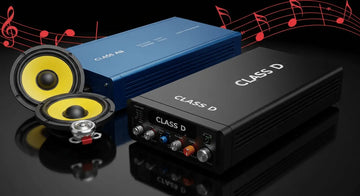
Class AB vs Class D Amplifiers: Which One Should You Choose?
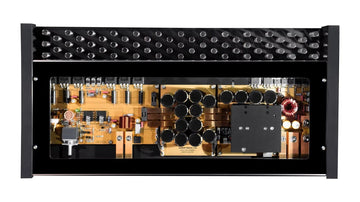
The Best Class A Amplifier: Key Features and Benefits Explained
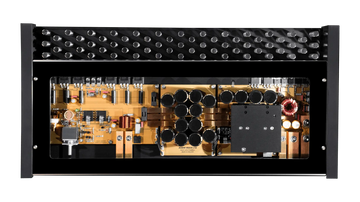
Class A Car Amplifiers: The Gold Standard in Sound Quality


